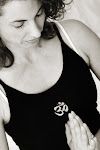I am amazed (and admittedly occasionally amused) watching us twist our bodies. We look a bit like contortionists, having lost the alignment of our spines, heads, and often limbs in the attempt of a deeper twist. When we lose the alignment and move into a deeper twist, not only have we lost the integrity of our body, we have lost our energy line as well. At best we don’t get the full benefits of the pose. At worst, we can damage our spine.
You need to view the spine as the axis around which you are twisting. That means keeping the spine long. There are several things your body can do to keep the spine long, although it might mean you won’t twist as far as you are used to twisting.
The first is to keep both sitting bones grounded. Feel both of them as you revolve. We tend to lose the sit bone we are turning away from and tip into our twist. Try a quick twist right where you are sitting. Can you feel the tip? We just tend to put more weight on the sitting bone we are turning toward.
Now an important aspect to keeping the sitting bones grounded is to allow them to shift slightly. I know this direction is contrary to what many teach, but allowing the sitting bones to twist slightly (so the sitting bone you are twisting away from moves forward slightly), keeps the spine in integrity. You are twisting the spine. The spine begins at the coccyx/sacrum which is part of the pelvis. If you don’t twist the hips slightly, you aren’t twisting the entire spine. Moreover, if you twist the spine while you keep the pelvis static, the sacrum may twist within the pelvis, torquing the sacro-iliac joint.
Okay, so you allowed the pelvis to shift slightly and you grounded the far sitting bone so you feel both sitting bones rooted, now you need to lengthen the spine right out of those sitting bones. As you lengthen, be sure to keep the torso aligned so you don’t tip the pelvis forward or back or take the ribs forward.
Now that the spine is long, you can begin to twist. Begin the twist from the base of the spine (the sitting bones) and feel it move up the spine. Visualize the twist occurring at each vertebra, not just your favorite two or three (somewhere in your mid-lower back). Feel long and keep your axis aligned over those sitting bones.
Ahhh…nothing like a good twist. Next, I’ll discuss twisting in integrity with your inner body.
Thursday, August 23, 2007
Monday, August 13, 2007
Feeling Complete with a Pose:
Whenever you do a pose, you should feel complete physically. In other words, if you feel you absolutely need to follow a pose to balance your body, or release physical tension from the first pose, something was wrong in your initial pose. If you do a backbend and can’t wait to twist or forward fold to release your lower back, you need to work on the alignment in your backbends. If you forward fold and can’t wait to twist to release the tension in your upper back, you need to work on the alignment in your forward fold. Every time you finish a pose, your body should feel balanced and complete.
I noticed this idea most in Ustrasana (Camel Pose). Every time I came out I couldn’t wait to drop to Balasana (Child’s Pose). I needed to release the tension in my lower back. When I finally realized I was not complete after Ustrasana, I began to work on my alignment. When I went into the pose with more control and didn’t go as deeply into the pose, my lower back didn’t need the release anymore. I still enjoy Balasana after Ustrasana, but I don’t need it to balance me.
I want to add one more point to this thought. You should feel complete physically, that doesn’t mean that energetically you should feel complete. In particular, regarding back bends and headstands. Back bends are incredibly stimulating and need forward folds to follow to calm the nervous system (especially if you are practicing at night and you want to sleep!) Headstands need to be followed by shoulderstand for the same reason.
I noticed this idea most in Ustrasana (Camel Pose). Every time I came out I couldn’t wait to drop to Balasana (Child’s Pose). I needed to release the tension in my lower back. When I finally realized I was not complete after Ustrasana, I began to work on my alignment. When I went into the pose with more control and didn’t go as deeply into the pose, my lower back didn’t need the release anymore. I still enjoy Balasana after Ustrasana, but I don’t need it to balance me.
I want to add one more point to this thought. You should feel complete physically, that doesn’t mean that energetically you should feel complete. In particular, regarding back bends and headstands. Back bends are incredibly stimulating and need forward folds to follow to calm the nervous system (especially if you are practicing at night and you want to sleep!) Headstands need to be followed by shoulderstand for the same reason.
Subscribe to:
Comments (Atom)


